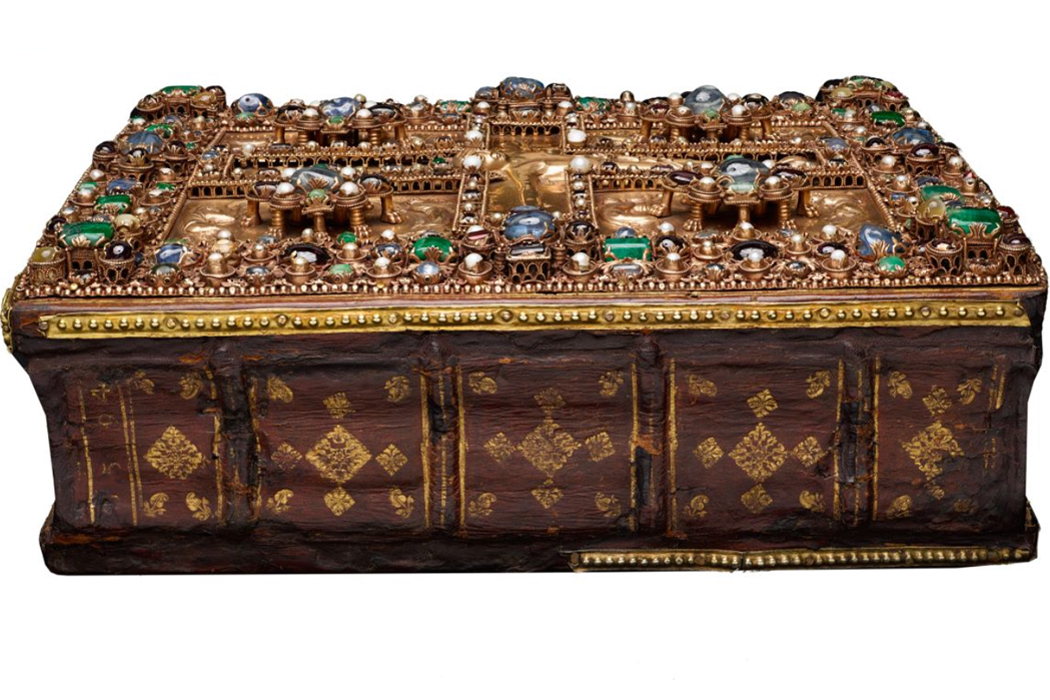The Lindau Gospels, a ninth-century illuminated manuscript encased in a gold binding encrusted with precious stones may now be seen in a brilliant light

The Lindau Gospels, a ninth-century illuminated manuscript encased in a gold binding encrusted with precious stones, was recently put on display in the east room of the Morgan’s original building on Madison Avenue. The great news are that it is shown in a brighter light than the standard 50 lux.
“Because it’s a binding, we can show it in brighter light than is normal,” Roger S. Wieck, the head of the department of medieval and Renaissance manuscripts, said in an interview to Artsbeat: “You really can see it so much better.” The quality of light will surely be especially appreciated by the elderly citizens, who often suffer from the shaded lights most curators prefer these days.
One of only three surviving goldsmith’s works from the court school of Charles the Bald, a grandson of Charlemagne, the book will be on view until 01.05.2016 before going into conservation in preparation for an exhibition in September 2017 (Word and Image: Martin Luther’s Reformation). The brighter display is part of a broader upgrade of the lighting in the Morgan’s landmark 1906 Charles McKim building, undertaken at the request of Colin B. Bailey, the library’s director.
The angled display of the Lindau Gospels, coupled with the improved lighting, allows visitors to see the three-dimensional details on the front cover, which was made circa 870-880, probably in Eastern France.
Named after the Abbey of Lindau on Lake Constance (Germany), where it was once housed, the Lindau Gospels ranks as one of the great masterpieces from the collection of the Morgan Library & Museum. Its jeweled covers constitute one of the most important of all medieval treasure bindings. Quite unusually, the manuscript’s exquisite covers are in fact from entirely different regions and moments in time. Dating to the late eighth century, the back cover is the earliest component of the book and was likely made in the region around Salzburg (Austria). The front cover, in contrast, dates to nearly a hundred years later (ca. 870–80) and was likely produced in what is today Eastern France. The manuscript itself is later still (ca. 880–90), and was certainly written and illuminated in the monastery of St. Gall (Switzerland). At some unknown point in time, precious silks from Byzantium and the Middle East were attached to the inside covers of the manuscript, thus adding yet another layer of complexity to this fascinating object.

The manuscript itself contains – according to the presentation at the Museum’s website – the text of the four Gospels along with standard supplementary material, such as the prologues of Jerome, prefaces for each of the Gospels, chapter listings, and twelve richly illuminated canon tables. Clearly inspired by textile designs, the two decorative pages that frame the manuscript’s canon tables, are a particularly unusual feature of the manuscript’s illumination. Nothing quite like them exists in any other manuscript from the period. Although the Lindau Gospels lacks portraits of the evangelists, as do several other examples of gospel books from St. Gall, the beginnings of the four Gospels are nevertheless distinguished through sumptuous double-page spreads, which feature the opening words of the respective Gospel text. As many as seven different scribes were engaged in the copying of the texts, and it is thought that a monk named Folchart—one of St. Gall’s preeminent artists—was personally responsible for some of the manuscript’s illuminated pages.
A large gold repoussé Crucifixion dominates this jeweled cover. Surrounding Christ are ten mourning figures: below the arms of the cross are the Virgin and John and probably Mary Magdalene and Mary, the wife of Cleopas. The cover’s architectural features allude to the jeweled Heavenly Jerusalem, the city made possible by Christ’s sacrifice. This cover and that of the Codex Aureus from St. Emmeram in Regensburg, now in Munich, are the two finest Carolingian jeweled bindings. It is speculated the cover may have been made at the Royal Abbey of St. Denis, where Charles the Bald was secular abbot from 867 until his death in 877.
However, this presentation of the Lindau Gospel hinders a view of the often forgotten back cover, which is the oldest jeweled binding in the Morgan. Although the precise date and origin of the back cover remain mysterious, it has been suggested that it was made around Salzburg during the time of Bishop Virgilius (d. 784). The main decorative motif is a cross, the arms of which broaden at their ends. In the central square are a topaz and four abbreviations: IHS XPS DNS NOS (Iesus Christus Dominus Noster—Jesus Christ Our Lord). Four champlevé busts of Christ framed by garnets extend from the square. Between the arms of the cross are four silver gilt panels with animal interlace. The four medallions with the Evangelists were added in 1594.
The book was acquired by J.P. Morgan in 1901for the sum of £10.000 is designated the Morgan’s M1.
SOURCE:
SEE MORE:
